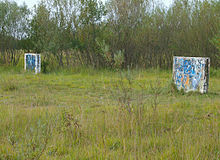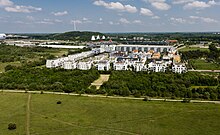Southern Fröttmaninger Heide
|
"Südliche Fröttmaninger Heide" nature reserve
|
||
|
Fröttmaninger Heide (photo from south) |
||
| location | Munich , Garching near Munich and Oberschleissheim , Upper Bavaria , Bavaria , Germany | |
| surface | 3.47 km² | |
| Identifier | NSG100.134 (PDF; 3.49 MB) | |
| WDPA ID | 555632900 | |
| Natura 2000 ID | [http://natura2000.eea.europa.eu/Natura2000/SDF.aspx?site=DE7735371 DE-7735-371 DE-7735-371 ] | |
| FFH area | approx. 332 hectares are part of the "heather areas and loh forests north of Munich", No. 7735-371 | |
| Geographical location | 48 ° 13 ' N , 11 ° 36' E | |
|
|
||
| Sea level | from 491 m to 497 m | |
| Setup date | May 9, 2016 | |
| Framework plan | Care and development concept Fröttmaninger Heide (2010) (PDF; 10.2 MB) | |
| administration | Government of Upper Bavaria | |
The southern Fröttmaninger Heide is an area on the northern outskirts of Munich that is protected by the nature conservation ordinance of the government of Upper Bavaria and the fauna-flora-habitat directive of the EU . It covers an area of 347 hectares and used to be a tank training area for the Bundeswehr . The area is one of the largest contiguous grass heaths in Central Europe . It is part of the Munich green belt . Of the once extensive heather area in the north of the state capital, only the neighboring Panzerwiese , the heaths in Mallertshofer Holz , the Garchinger heath and the heaths near Oberschleißheim exist today, besides the Fröttmaninger heath .
location

In the south, the Fröttmaninger Heide borders the residential areas of the Freimann district ( Freimanner Heide and Nordhaide ). In the west it extends to the grounds of the Fürst-Wrede-Kaserne and the Helmholtz Zentrum München or to Ingolstädter Landstrasse. In the east it ends at the tracks of underground line 6 in the area of the Fröttmaning stop . To the east of Fröttmaninger Heide are the Holy Cross Church of the former village of Fröttmaning and, since 2005, the Allianz Arena football stadium . In the north, the protected area ends on the A99 motorway . North of the autobahn, the heathland continues until shortly before Garching-Hochbrück. This part is still used as an on- site training area by the Bundeswehr.
The Fröttmaninger Heide lies on the districts of Oberschleißheim , Garching and most of it in Munich in the Freimann district . Since June 27, 2007, the owner has been the Heideflächenverein Münchener Norden eV , in which the aforementioned municipalities as well as Eching , Neufahrn and Unterschleißheim as well as the districts of Freising and Munich are members.
history
As early as the middle of the 19th century, the military, including the artillery of the Bavarian army , was using the Fröttmaninger Heide for field exercises and as a parade and shooting range. In 1935, when the Wehrmacht was arming the northern part of the area, an auxiliary ammunition facility for the army was established, and the entire area continuously served as a firing and training area. During the Cold War , the US Army claimed the Fröttmaninger Heide as a training area. From 1956 the land gradually became the property of the Federal Republic of Germany . From 1971 to 1972 the US Army withdrew completely from the training area. Most recently, the Bundeswehr used the Fröttmaninger Heide for its regional armed forces for military field training.
The Munich urban development plan of 1975 provided for a green network with a new West, East and North Park; The Fröttmaninger Heide was planned as the north park. In 1973 the future north park in the Fröttmaninger Heide was named as a location for a possible application by the city of Munich for the International Horticultural Exhibition 1983. In 1976 it became apparent that a horticultural exhibition in the Nordpark - because of its location away from densely built-up city districts, without suitable areas for exhibition halls and because of its enormous size - could not expect any funding from the Free State of Bavaria and the federal government. That is why the idea came up to hold the IGA in Westpark , which was then implemented.
Since May 2012, the area has been provisionally secured before it can be used, in anticipation of an early designation as a nature reserve . A public participation process ran from January 2012 to May 2015 . It ended with a compromise that the site should be divided into four zones in which different regulations apply. After the demands of the Heide interest group for further relaxation in favor of those looking for relaxation found some support in the Munich city council in the summer of 2015, the ordinance on the “Südliche Fröttmaninger Heide” nature reserve was issued on April 8, 2016 by the government of Upper Bavaria .
Load with ammunition and ordnance
The Fröttmaninger Heide is heavily burdened with relics from the Second World War: ammunition, grenades, duds, ordnance. Some of the substances, some of which come from the repeated bombing of a military training area, are only a few centimeters below the surface of the earth. The search for ordnance and clearance activities will continue.
Heathland
The Fröttmaninger Heide is located on the Munich gravel plain in the sub-area of the Garching gravel tongue . Worm Ice Age gravel deposits from the Isar shape the bottom. The soil type is a shallow and nutrient-poor arable pararendzina with high water permeability and low filtering capacity. The varied network of biotopes includes semi-dry and dry lawns, open gravel areas with ponds and pioneer vegetation, as well as light pine forests.
The special character of the open heather locations results from the combination of dry soil due to the water-permeable gravel subsoil and traditional pasture use . The latter prevents trees from growing and is now carried out by sheep or replaced by an annual mowing for nature conservation purposes.
Flora, Funga and Fauna
The species-rich heather area is home to plants such as tufted chickweed , German cheeky clover , keel leek , long-leaved rabbit's ear , silver thistle , gray scabies and German gentian . There are a total of 352 different plant species in the Fröttmaninger Heide.
The mushroom society of open grassy areas is of Rötlingen dominated, including colorfully species like the Montane Blue Stalk Zärtling which Blaublättrige Zärtling and the Brown Green Zärtling . There are also species with inconspicuously colored fruiting bodies, such as B. the funnel-like fondling , the flaky umbilical rötling and the brown-leaved navel rötling . Of the nationwide protected juices, the lime-loving saffron yellow juices are particularly common. With the steppe Egerling and the steppe funnelling , two rare species are native. In addition, the small-spore woodpecker tintling could be detected. The fuchsia-brown crack fungus is a real rarity, which was probably found here for the first time in Bavaria.
The animal world includes u. a. Pheasant , Feldlerche , flow Plover , Goldammer , Heidelerche , Buzzard , partridge , Schwarzkehlchen , Steinschmätzer , Stieglitz , Kestrel , Zauneidechse , toad and frog and 41 butterfly species such as ocher Bindiger Samtfalter , PLEBEJUS IDAS and carcharodus alceae . Also to be found are the blue-winged wasteland insect , spotted club insect , green hay horse , small heather grasshopper and two-colored bite insect .
Individual evidence
- ^ Society for Development, Procurement and Operation mbH (gebb), Cologne: The heath is blooming. (No longer available online.) June 27, 2007, archived from the original on November 22, 2013 ; Retrieved May 5, 2012 . Info: The archive link was inserted automatically and has not yet been checked. Please check the original and archive link according to the instructions and then remove this notice.
- ↑ Andreas Weiß: Fröttmaning - The great withdrawal of troops. In: Wochenanzeiger Munich; Edition "Münchener Nord-Rundschau". July 3, 2007, accessed May 5, 2012 .
- ^ Bundeswehr: Munich location brochure . 1st edition. No. 80331067 , 2007, p. 32 ( PDF; 3.77 MB ).
- ↑ IGA 83 in Munich - Why? - Interview with the head of the City Garden Directorate Josef Wurzer. In: Garten + Landschaft, edition 4/83, pages 267 f.
- ↑ Government of Upper Bavaria: Ordinance on the temporary securing of the Fröttmaninger Heide - southern part in the state capital of Munich and in the district of Munich as a nature reserve and regulating access to the Fröttmaninger Heide - southern part of April 26, 2012 . In: Upper Bavarian Official Gazette . No. 9 , May 4, 2012, p. 58 ff . ( PDF; 2.6 MB ).
- ↑ PAN Planning Office for Applied Nature Conservation GmbH and Elmauer Institute: Citizen Participation - UnserHeide.de. Retrieved June 26, 2013 .
- ↑ https://www.sueddeutsche.de/muenchen/freimann-vier-brisante- Zonen- 1.3000255
- ↑ Thomas Kronewitter: Mines under grasslands. In: Süddeutsche Zeitung online , Munich. December 16, 2010, accessed December 16, 2010 .
- ↑ https://www.sueddeutsche.de/muenchen/landkreismuenchen/froettmaning-heide-kampfmittel-raeumung-naturschutz-1.4559316
- ↑ Formation of the landscape. Heideflächenverein Münchener Norden eV, Unterschleißheim, accessed on May 5, 2012 .
- ↑ Sonja Wiedemann: The development of the forest and heathland in the north of Munich between 1800 and 2000. (PDF; 6.0 MB) Diploma thesis at the University of Applied Sciences Munich. (No longer available online.) 2007, p. 10 f. , formerly in the original ; Retrieved May 5, 2012 . ( Page no longer available , search in web archives )
- ↑ https://www.sueddeutsche.de/muenchen/fluss-heideflaechen-und-waelder-muenchner-biotope-1.4295421
- ↑ Matthias Dondl: Day of biodiversity in the Fröttmaninger Heide. Excursion report of the Association for Mushroom Science Munich eV from June 27, 2009. Retrieved May 5, 2012 .
- ↑ Matthias Dondl: Inocybe determinations 2009; Portrait No. 10: Foxy-brown crack fungus ( Inocybe vulpinella ). Retrieved May 5, 2012 .






